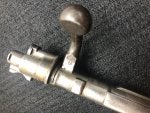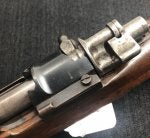That is a nice story but it doesn't hold water. Not only was the VZ24JC barrel different (thinner and 7X57) from a Czechoslovak Army VZ24 barrel, but the stock (thinner overall but cut thicker for the thinner barrel) and bolt (bent handle) were also different. The receiver of a Czechoslovak Army VZ24 is different from a "South China" VZ24JC in regard to the serial number pattern and the lack of an E(lion)29 acceptance marking. So if you don't use the barrel, stock, bolt, or receiver of a VZ24 rifle to make a VZ24JC rifle, what would be the point of starting with rifles 'borrowed' from the Czechoslovak Army?
The VZ24JC concept was a redesigned model intended to be a lightweight version of the VZ24. Most major parts were not interchangeable between the two designs.
The idea of the lightweight VZ24 was continued with the VZ32 rifle sold to Peru in 1934 and to Uruguay in 1937. The VZ32 stock proved to be fragile because it was too thin; the final (successful) version was the VZ12/33 sold to El Salvador in 1937 and sold in very large quantity to Brazil as the M1908/34 in 1937. The only difference between the VZ12/33 and the M1908/34 is the length of the bayonet lug (shorter on the M1908/34 and standard length on the VZ12/33).
The idea of the VZ24JC being sold to Brazilian rebels is generally accepted. The idea of using 'South China' as a cover story sounds possible, lacking other evidence. It was common for ZB to 'borrow' unissued (but acceptance marked and serial number marked) rifles from the Czechoslovak Army to make a quick sale and this might have been considered for the Brazilian rebel rifles - but it was not done.
It may have not been done because ZB already had VZ24JC rifles on hand from an unpaid Chinese contract.
I thought that would ruffle some feathers, the Francev report conflicting from what has been the accepted story. First, I should point out that Francev's book is very recent (publ 2015) compared to Franek (1969-70) or Sada (1971) - probably the main sources of previous knowledge - and we should expect new findings. Francev certainly did find many new details. I don't think he made them up.
The point of using Czech army stores (which the ZB company called "borrowing") was the time crunch. The Vargas people signed the contract in December 1929 with the delivery deadline of April, 1930. ZB started making the new parts in February 1930, and the stored rifles were officially released to ZB in March 1930. They evidently thought this would save time to meet the deadline. In the meantime, the Brazilian elections were held in March 1930 where Vargas technically lost but voting irregularities lead to the Brazilian Revolution of 1930. They probably had other things to worry about than paying ZB. When the smoke cleared, Vargas was in charge and due payments were made; then ZB shipped the rifles and machine guns.
When a rifle receives a new barrel and bolt, it needs to be newly proofed. The Czech army acceptance marking you refer to meant more than just that the rifle went into army inventory. It meant it passed some exacting quality checks required by the Czech army. They would not want this army quality mark on a rifle that received a new barrel,etc unless it went through the testing again. Since the rifle is not going back into the Czech army, there would be no new testing of this kind and no new army acceptance stamp. So, the acceptance stamp is removed, and might as well place a new serial number specific to the contract.
The Czech army wanted their acceptance marks removed or defaced when a rifle from army stores was exported. However, that was sometimes not practicable as with the huge 300,000 rifle first contract order from Romania that had to be done expeditiously.
The Chinese were most interested in buying as many weapons as possible for the money. In the 1920's, they searched far and wide for cheap used rifles (esp. Gew98's and Gew88's) in quantity. They would buy the more expensive new weapons if they could not find enough used guns. They would certainly not be interested in paying extra for curved bolts and relieved stocks - and, you say, special thin barrels.
The Brazilians, on the other hand, did not shrink from the extra cost of special features and special models. If the Vz.24JC is a special (therefore more expensive) "lightweight" version, that would be a reason the Chinese would not be interested, but the Brazilians might be.
PS: When the "sneaky" deal with the Brazilians became known, there was fear of scandal and some ZB officials were punished. They got off light because the Foreign Minister, Edvard Beneš, knew about it and came to their defense.























